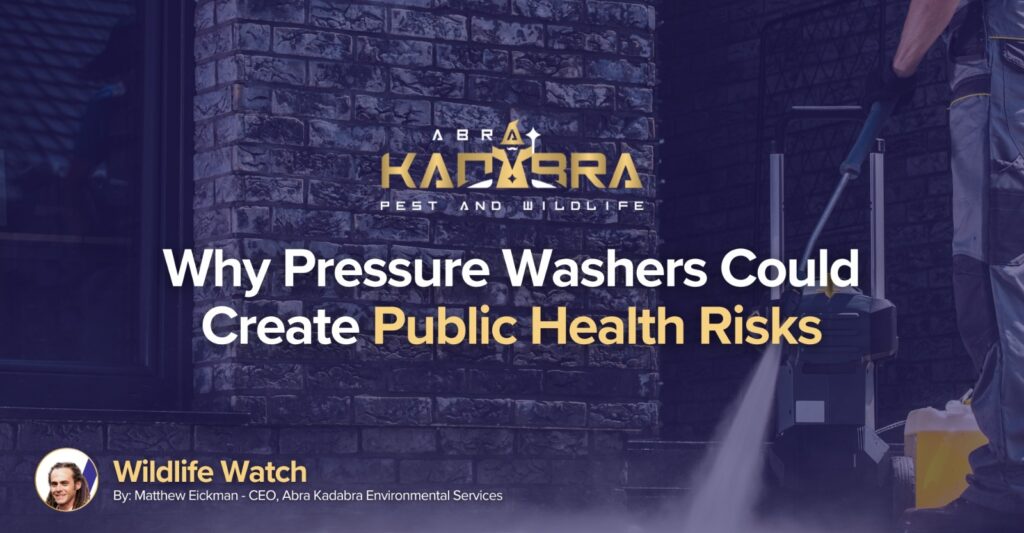Pigeon droppings are an unfortunate but familiar part of life in urban environments like Minneapolis and St. Paul. You’ll find them on building ledges, sidewalks, HVAC units, rooftop equipment, and transit infrastructure. It’s easy to assume a quick blast from a power washer is the best way to clean it up, but this approach can create a much more dangerous situation.
If you’re a maintenance professional, property manager, or city employee, this blog will guide you on what you need to know before reaching for that high-pressure hose.
Why Pigeon Droppings Are More Than a Mess
Pigeon feces harbor several dangerous pathogens, many of which are invisible, airborne, and resilient. These include:
- Histoplasma capsulatum – A fungus that causes histoplasmosis, a severe respiratory infection
- Cryptococcus neoformans – Another fungus that can cause pneumonia and spread to the brain
- Chlamydia psittaci – bacteria that cause psittacosis, a flu-like illness
- Campylobacter – bacteria that cause gastrointestinal illness
- Allergens – Chronic exposure can lead to hypersensitivity pneumonitis, or “breeder’s lung.”
These illnesses are most often transmitted when dry droppings are disturbed and become airborne, which is precisely what power washing does.
The Problem with Power Washing
1. It Aerosolizes Dangerous Pathogens
The high-pressure spray doesn’t just move droppings—it blasts them into tiny particles that become suspended in the air. Anyone nearby, especially workers or pedestrians, can then inhale fungal spores or bacteria-laden dust. Once airborne, these contaminants can spread well beyond the immediate area.
According to NWCOA and CDC guidelines, aerosolized pigeon feces are among the leading causes of histoplasmosis outbreaks in urban environments.
2. Contaminated Runoff Puts Ecosystems at Risk
In cities like Minneapolis and St. Paul, power washing waste often flows into storm drains that lead directly to rivers and lakes, including the Mississippi River. That runoff can carry fecal bacteria and fungal spores into the water supply or recreational areas, creating environmental and public health hazards.
3. It Violates Best Practices for Biohazard Cleanup
Cleanup of pigeon droppings—especially in areas with long-term accumulation—is classified as biohazard remediation. OSHA and environmental health professionals recommend controlled removal, not aggressive disturbance. Power washing violates nearly every principle of safe zoonotic control unless combined with protective barriers, respirators, and disinfectants—none of which are standard for typical maintenance crews.
What You Should Do Instead
The Safe and Responsible Way to Handle Pigeon Droppings
- Assess the site – Especially if it’s near air intakes, ventilation systems, or pedestrian areas
- Pre-treat surfaces – Use a 10% bleach solution to suppress dust and kill pathogens before disturbing
- Use PPE – Workers should wear full-face respirators with HEPA filters, gloves, goggles, and protective clothing
- Manual removal – Droppings should be carefully scraped, bagged, and removed—not blasted into the air
- Engage trained professionals – Work with wildlife control operators or environmental cleaning specialists who follow NWCOA guidelines
Local Perspective: Why This Matters in the Twin Cities
In Minneapolis and St. Paul, the urban infrastructure is home to large populations of pigeons. Areas like Nicollet Mall, the Stone Arch Bridge, the Green Line LRT, and downtown parking ramps are all frequent roosting sites. Accumulations of pigeon droppings are not just unsightly—they can compromise building materials, clog roof drains, and endanger public health if not adequately addressed.
How Abra Kadabra Can Help
Abra Kadabra has certified bird and zoonotic disease specialists who can assist your home or company in developing a comprehensive bird management program designed to address your particular concerns and limitations. We are a second-generation family-owned company with 20 years of experience. We are here to help and provide a service you can trust.
When your home is experiencing a wildlife problem, it is important to have the animals removed and the entry points sealed up (to prevent re-entry) before doing a thorough waste cleanup. At Abra Kadabra, we follow the National Wildlife Control Operators’ Association’s (NWCOA) 4-step inspecting, removing, monitoring, and repairing process. We always confirm the target species and identify the areas of activity and entry points, trap out the animals, and then exclude (wildlife-proof) the structure.
Once completed, we can remove, disinfect, or encapsulate contaminated materials to eliminate dangerous waste products and any pheromones near entry points. Note that disinfectant can be used at the first appointment when the waste is in a high-risk area, such as a kitchen or a child’s room.
Final Word
Power washing pigeon droppings may seem like a quick fix, but it creates far more risk than reward.
Whether you manage a commercial property, city building, or residential complex, it’s critical to approach pigeon waste cleanup as a biohazard, not a pressure washing job. Protect your team, your tenants, and your city by following proper protocols or hiring experts who can do it safely.
When it comes to pigeon poop, don’t spray—contain.

